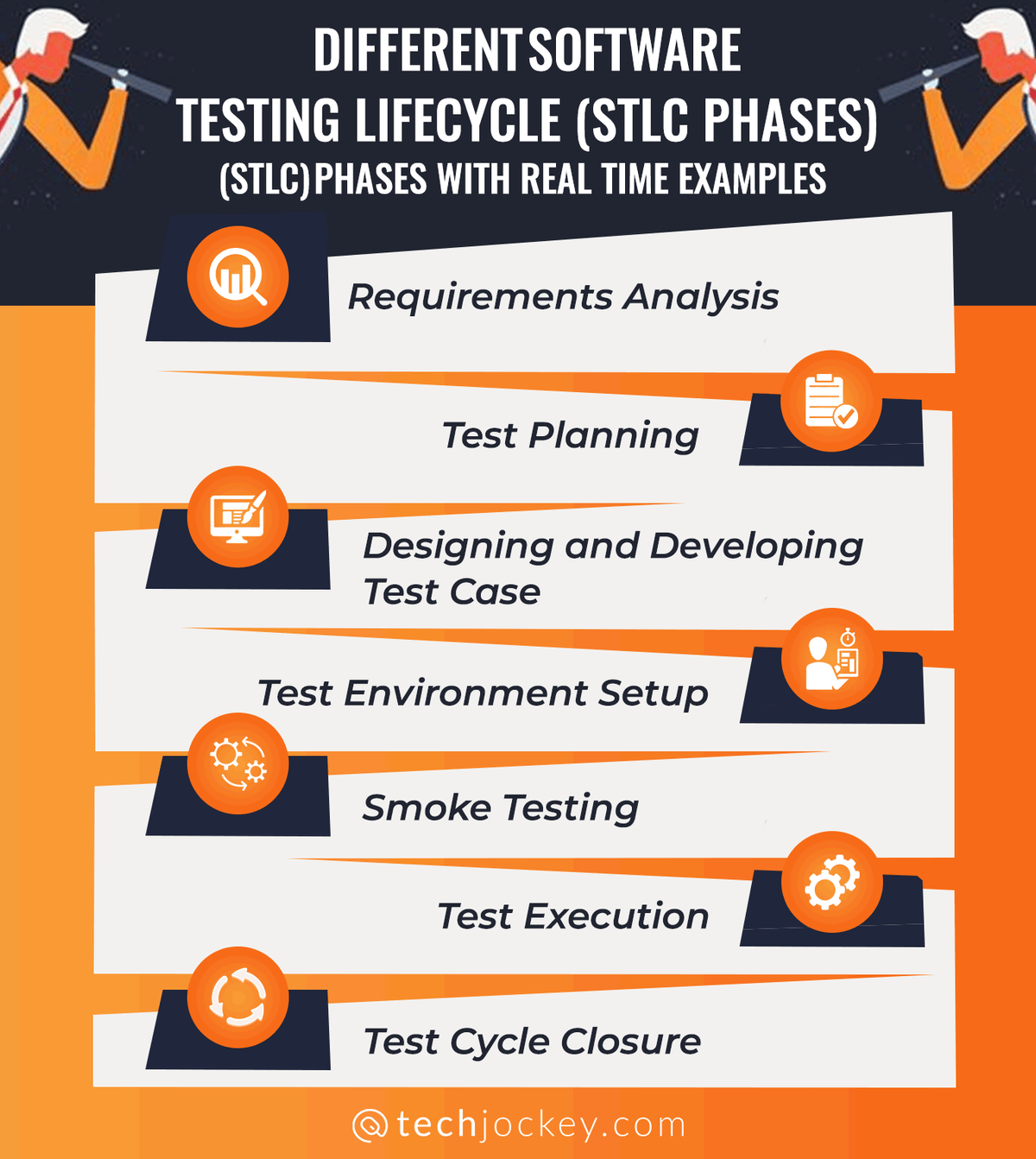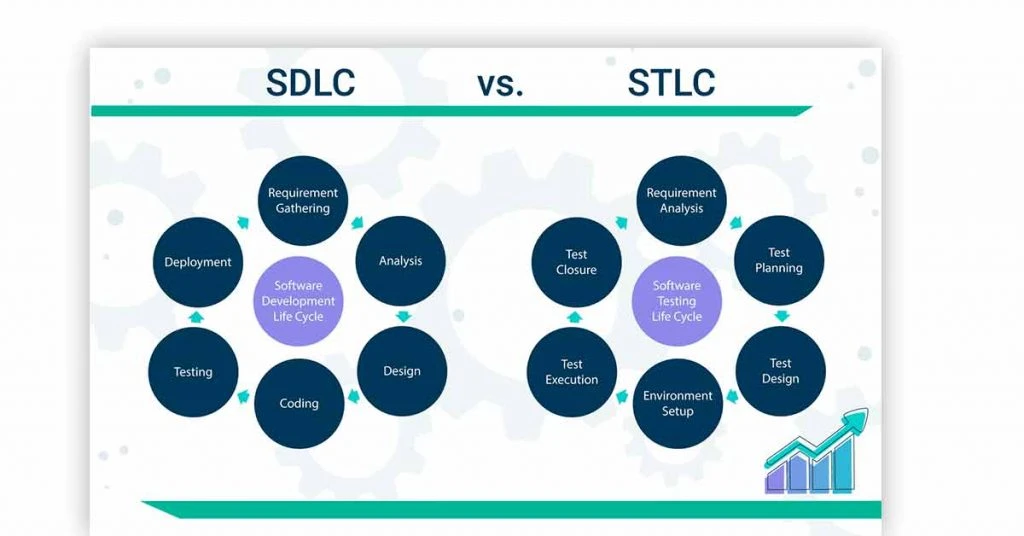What makes a difference between good software and great software is ‘Testing’. A systematically tested application provides a seamless user experience and could build regular users for a company. Besides, testing helps programmers avoid potential disasters and cost implications by identifying bugs, loopholes, security vulnerabilities, compliance gaps, data flow, etc.
However, random unorganized testing doesn’t do any good and makes the deployment process even more complex. Application testing only improves the final product if the testing strategy is planned and executed perfectly in a sequence called Software Testing Life Cycle or STLC.
This article aims to provide you with all that information on testing Life Cycle, and its importance. We will also inform you of all 6-software testing life cycle phases:
- Requirement analysis
- Test planning
- Test-Case design and development
- Environment setup
- Execution
- Cycle Closure
In the end, this article will also tell you how organizations can build an efficient STLC process.
What Is Software Testing Lifecycle (STLC)?
Software testing is a systematic approach to evaluating the quality of all aspects of the Software. In simple terms, software testing is the process followed by your in-house team of trained professionals before deployment to find any defects and suggest potential improvements to ensure the optimum end-user experience.
However, software testing is not a one-time task and needs to be performed in sequential order, which constitutes software testing life cycle (STLC) or application testing life cycle. Application Testing Lifecycle is one of the most important phases of software development, executed after the Implementation Phase but before deployment.
STLC is an organization-wide ongoing effort that every developed Software should go through for validation and verification. Every aspect of the software, including user interface, features, security, reliability, accuracy, interoperability, compliance, etc., is tested thoroughly to deploy an efficient and flawless application. The process involves finding defects and includes suggesting improvements to reduce complexity and increase the usability of the Software.
Suggested Read: Manual Testing vs Automation Testing: Differences
How Does Software Testing Lifecycle (STLC) Work?
Application Testing Lifecycle is a flow of actions to evaluate a software product and its performance concerning the specified requirements. Here is how the STLC life cycle process works:
Executed Sequentially: The software testing process is a sequential task. It is divided into multiple software testing steps that must be performed in order.
Repeated in Circularly Structured Workflow: STLC is the continuous ongoing task structured in a circular flow. Once the code is implemented, it goes through software testing steps to find defects and improvements. Then the Software is again modified and tested from scratch. The process is repeated until the software is deemed perfect for deployment.
Strategically drafted: All the phases of testing life cycle are carefully drafted in phases of testing life cycle according to the objectives and expectations from the software.
Multi-faceted: The software testing life cycle is not unidimensional. It covers many different dimensions of software like security, user experience, complexity, data flow, etc.
Organization-wide: Application testing is an organization-wide process. It involves the flow of data from top to bottom and then bottom to top. It also horizontally integrates all the teams across organizations involved in the development lifecycle.
Ongoing effort: STLC is only beneficial if it involves continuous learning and improvement. Testing is not a one-time verification but requires an ongoing compatibility and interoperability test according to changing environments for deployment.
Ex: Once Windows 11 is out for use, an application that is already tested in Windows 10 must be tested again for Windows 11.
Importance of Software Testing Lifecycle (STLC)

STLC is an inseparable part of the entire development and deployment process. Here are some of the reasons why Software Testing Cycle is a crucial part of the software development process:
Ensuring quality: The primary purpose of software testing is to identify and remove defects, check compatibility and usability of the software product. It ensures that the product is of the best possible quality and meets all the customer’s expectations.
Identifying bugs and Loopholes: STLC helps eliminate bugs and loopholes in a software. This is important to create a seamless user experience and avoid potential security risks.
Reducing Complexity: Testing team could identify potential areas where unnecessary steps can be eliminated to optimize the software architecture.
Ensuring Compliance: Software products need to meet specific industry or organization-specific standards before those can be released for the end users. Lifecycle testing helps in identifying any compliance issue and fixing them before release.
Uncovering Hidden Dependencies: Comprehensive testing can help unveil hidden dependencies between modules, systems and databases. It also assists in improvising integration plans for developers and contributors.
Suggested Read: Best Open Source Testing Tools List to Choose From
Different Software Testing Lifecycle (STLC) Phases with Real Time Examples

Software Testing Lifecycle (STLC) is a process used to ensure the user-friendliness of any software. There are different phases of testing lifecycle. Let’s look at each of these software testing steps in detail with real-time examples:
- Requirements Analysis
This is the first phase of the software testing lifecycle in which testers gather all the requirements for the Software. This includes the performance, functionality, and security criteria that clients or developers expect the application to meet.
Testers need to know the objectives and acceptance criteria before creating strategy and test cases. For example, if a client wants payroll software, they will describe the necessary modules, interface, and the expected output from the software.
- Test Planning
Once the software requirement is clear, the test planning phase begins. In this phase, managers create workflow, define time schedules, assign teams, deploy resources, and make the optimum testing strategy.
The plan includes details of testing cases, activities, hierarchy, time estimation, testing tools required, and training requirements. The test plan documentation informs testers and other departments about the process flow, commencement, QA works, roles, deadlines, etc.
It also mentions the details of test environments, functional tests, non-functional tests, etc.
- Designing and Developing Test Case
A Test case is a set of inputs, conditions, or procedures that should produce the desired output when fed into the programme.
For example, if there is a software that checks whether a given number is odd or even, the programme should return the Value “even” for every input divisible by 2; else, return the value “odd”.
The test case would be to enter a series of random natural numbers with already known results. Test Case: The number to be entered is 5 and the expected result should be “Odd”.
Designing and developing test cases is an essential stage of testing. Software testers carefully study all the requirements and acceptance to create test cases. Test cases should be extensive and contain all the possible combinations of cases. It should cover any unique values or inputs as an exception or error.
For example, “0” is an exceptional even number that should be added as an exception in the code that checks odd or even numbers.
- Test Environment Setup
This phase mainly defines the environment for testing, which includes the required hardware, software, servers, and frameworks. The test environment must be set up according to the user’s point of view (POV) and the Software’s end goal.
A uniform test environment setup should be established before starting test execution to ensure that the application performs similarly through all the devices. The analyst can define the minimum hardware and software requirement for each level of performance and Smoke-test the Test Environment in this phase
- Smoke testing
Smoke testing is the initial rapid test done to ensure whether a software is stable in the test environment.
Example: If there is an Android application being developed, the testing team must define the Software- Android Version (9.0, 10.0, 11.0, etc.), hardware- 2GB,4GB, etc. or network -4G or 5G on which the Software would be tested for the required performance.
This ensures that an application that runs on Android 11.0 with 6 Gb RAM would also run smoothly on Android 10 with 4 GB RAM.
Suggested Read: Best Bug Tracking Tools to Resolve Bugs and Issues
- Test Execution
Everything will then sum up to this phase as it is the core of the STLC Life Cycle process. All the test cases are executed in this stage of the testing life cycle. Cases are sequentially entered into the product and then the output for each test case is recorded.
Then, the inputs are cross-matched with anticipated results, and any discrepancy is documented and passed to the developer team for debugging and fixes. Once the software is debugged, the product is completely tested from scratch again to identify any other bug after the initial fix.
- Test Cycle Closure
This is the final stage of the application testing life cycle. Team leaders verify that all test cases are executed properly and any deviation from anticipated result is documented and communicated to the developer team. Also, all factors like test coverage, quality, cost and timeline are carefully evaluated and recorded.
A detailed test closure report is prepared, including all the documentation, results, outcomes, usability and efficiency of the software. The testing team also notes down learnings from the entire process for future reference and optimization of the test process.
STLC Vs SDLC: What’s the Difference Between SDLC and STLC

SDLC Vs STLC: Overview
Software Development Life Cycle (SDLC) is the complete process of software development that includes all aspects of software development and deployment.
However, software testing life cycle is a series of tasks designed to test an application’s functioning.
SDLC Vs STLC: Phases
Major Phases of SDLC are Planning, Analysis, Design, Implementation, Testing, Integration and Maintenance.
Software testing Life Cycle phases are: Requirement analysis, Test planning, Test-Case design and development, Environment setup, Execution and Cycle Closure phase.
SDLC Vs STLC: Objective
SDLC is a parent process that focuses on building and deploying high-quality software as per the users’ requirements.
STLC is a subset that focuses on testing a product to ensure that the application functions as required.
SDLC Vs STLC: Commencement
Application Development Life Cycle phases begin by understanding and analysing the requirement and problem statement that software should solve.
The testing cycle starts once the software is fully implemented but before deployment.
SDLC Vs STLC: Responsibility
Software development life cycle is headed by Software Development Manager and includes all other teams Project manager, product owners, team leaders, QA teams, Front End developers, Back-end developers, full stack developers, including the Testing team.
Generally, a QA manager heads the testing lifecycle, It includes other members like QA team members, Product analysts, software test engineers, etc.
Suggested Read: Best IoT Device Management Platforms & Software
The Role of STLC is SDLC
Developing software that meets all the user requirements is an extremely complex process. While every phase of SDLC is crucial, the testing phase is critical. It helps identify any potential defects or unwanted complexity, ensuring that end users have an uninterrupted experience.
STLC helps identify any potential security threats, compliance gaps, loopholes, and bugs that may have serious cost and reputation implications if not identified on time.
From identifying and eliminating unwanted complexity to smoothen the functioning of every feature. Testing makes sure that the software meets every expectation of developers, clients, and consumers.
Testing is not just another phase in SDLC before deployment. It is a stage where software is rigorously checked, ensuring that the product is continuously improvised for optimum performance, efficiency, security, and usability.
How to Make Your Software Testing Lifecycle (STLC) Efficient?

Software Testing Life cycle is not just about finding bugs but also the efficient utilization of time, resources and people involved in Software Development Process. An efficient STLC process could cut costs and help build loyal clients for the company.
Here are some of the ways to make the STLC efficient for maximum productivity.
Automation: Testing is a repetitive process that needs to be executed multiple times. Writing scripts to test cases can help speed up the process and ensure consistent results. Additionally, it can help reduce the amount of manual effort required, saving both time and money.
Documentation: Another way to make your STLC efficient is by ensuring that all documentation is up to date and accurate. It allows team members to understand the process quickly, helping them avoid potential issues further down the line.
Training: Training ensure that everyone understands the process and knows how to use the tools correctly. Specializing employees in a specific testing phase boost productivity and decrease resistance.
Deployment of Resources: Assigning the most eligible people to a task with the necessary skills, tools and knowledge make the STLC life cycle process much more efficient. It may also involve investing in tools and infrastructure that can help improve efficiency.
Well-defined Workflow: A well-defined workflow that is followed consistently ensures that all steps are carried out correctly without any confusion. By defining a clear workflow at the start of the process, organizations can save a lot of time and effort.
Prioritizing Test Cases: Focusing on the most important test cases first ensures that critical issues are identified and resolved quickly. By taking a proactive approach to test case prioritization, organizations can improve the efficiency of their STLC.
Continuous learning and Improvement: Organizations should constantly review their processes and procedures and identify areas of improvement. Additionally, it requires team members to be open to new ideas. By continuously learning and improving, companies could optimize STLC.
Suggested Read: Best Free & Paid Online Android Emulator Apps for PC
FAQs
What is the difference between Software Development Life Cycle and Software Testing Life Cycle?
Software Development Life Cycle (SDLC) is a parent process that includes all the phases of building and deploying high-quality software, from analysis to maintenance.
In contrast, Software Testing Life Cycle (STLC) is a part of SDLC that focuses on testing an application to ensure that it functions as required.What is Software Testing Life Cycle in agile?
Agile testing is a process in which testing, and development processes begin simultaneously. It doesn't follow the traditional waterfall method, where product testing begins only after the implementation phase.
When should software testing activities start?
The software testing phase typically starts after the implementation and before deployment. However, in many cases like agile software development, the testing activities are performed along with the development phase.
In the Software Development Life Cycle who is the best person to catch a defect?
Business analysts are the best person to catch a defect in STLC as they have complete visibility into the entire testing process, from drawing requirements to process assessment.
What are the phases involved in Software Testing Life Cycle?
There are five main phases of testing life cycle: Requirement analysis, Test planning, Test-Case design and development, Environment setup, Execution and Cycle Closure phase.
What is STLC in Software Testing?
Software Testing is a part of SDLC that checks the usability of software. STLC in software testing is a carefully designed series of activities to test the performance, usability and security of a software.
Rajan is pursuing CA with a keen interest in trends and technologies for taxation, payroll compliances, Tally Accounting, and financial nuances. He is an expert in FinTech solutions and loves writing about the vast scope of this field and how it can transform the way individuals and businesses... Read more


























